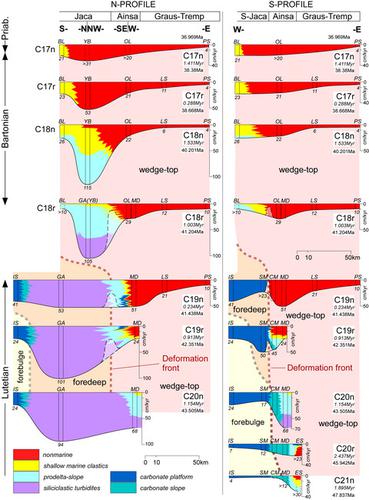当前位置:
X-MOL 学术
›
Basin Res.
›
论文详情
Our official English website, www.x-mol.net, welcomes your feedback! (Note: you will need to create a separate account there.)
10 Myr evolution of sedimentation rates in a deep marine to non‐marine foreland basin system: Tectonic and sedimentary controls (Eocene, Tremp–Jaca Basin, Southern Pyrenees, NE Spain)
Basin Research ( IF 3.2 ) Pub Date : 2020-06-07 , DOI: 10.1111/bre.12481 Andreu Vinyoles 1, 2 , Miguel López‐Blanco 1, 2 , Miguel Garcés 1, 2 , Pau Arbués 1, 2 , Luis Valero 2, 3, 4 , Elisabet Beamud 2, 3 , Belén Oliva‐Urcia 5 , Patricia Cabello 1, 2
Basin Research ( IF 3.2 ) Pub Date : 2020-06-07 , DOI: 10.1111/bre.12481 Andreu Vinyoles 1, 2 , Miguel López‐Blanco 1, 2 , Miguel Garcés 1, 2 , Pau Arbués 1, 2 , Luis Valero 2, 3, 4 , Elisabet Beamud 2, 3 , Belén Oliva‐Urcia 5 , Patricia Cabello 1, 2
Affiliation

|
The propagation of the deformation front in foreland systems is typically accompanied by the incorporation of parts of the basin into wedge‐top piggy‐back basins, this process is likely producing considerable changes to sedimentation rates (SR). Here we investigate the spatial‐temporal evolution of SR for the Tremp–Jaca Basin in the Southern Pyrenees during its evolution from a wedge‐top, foreredeep, forebulge configuration to a wedge‐top stage. SR were controlled by a series of tectonic structures that influenced subsidence distribution and modified the sediment dispersal patterns. We compare the decompacted SR calculated from 12 magnetostratigraphic sections located throughout the Tremp–Jaca Basin represent the full range of depositional environment and times. While the derived long‐term SR range between 9.0 and 84.5 cm/kyr, compiled data at the scale of magnetozones (0.1–2.5 Myr) yield SR that range from 3.0 to 170 cm/kyr. From this analysis, three main types of depocenter are recognized: a regional depocenter in the foredeep depozone; depocenters related to both regional subsidence and salt tectonics in the wedge‐top depozone; and a depocenter related to clastic shelf building showing transgressive and regressive trends with graded and non‐graded episodes. From the evolution of SR we distinguish two stages. The Lutetian Stage (from 49.1–41.2 Ma) portrays a compartmentalized basin characterized by variable SR in dominantly underfilled accommodation areas. The markedly different advance of the deformation front between the Central and Western Pyrenees resulted in a complex distribution of the foreland depozones during this stage. The Bartonian–Priabonian Stage (41.2–36.9 Ma) represents the integration of the whole basin into the wedge‐top, showing a generalized reduction of SR in a mostly overfilled relatively uniform basin. The stacking of basement units in the hinterland during the whole period produced unusually high SR in the wedge‐top depozone.
中文翻译:

10海洋至非海洋前陆盆地系统深部沉积速率的Myr演化:构造和沉积控制(始新世,特伦普–贾卡盆地,南比利牛斯山脉,西班牙东北)
前陆系统中形变锋的传播通常伴随着盆地的某些部分合并到楔顶背piggy式盆地中,这一过程很可能使沉积速率(SR)发生很大变化。在这里,我们研究了南比利牛斯山特里普-贾卡盆地SR的时空演化过程,即从楔顶,前深,前隆起构造到楔顶阶段。SR受一系列构造结构控制,这些构造结构影响了沉降的分布并改变了沉积物的扩散方式。我们比较了从整个Tremp–Jaca盆地中的12个地磁地层计算得到的解压后的SR,代表了整个沉积环境和时间范围。虽然得出的长期SR范围为9.0至84.5 cm / kyr,在磁区范围内(0.1-2.5 Myr)编制的数据产生的SR范围为3.0至170 cm / kyr。通过这种分析,可以识别出三种主要的沉积中心类型:前深部沉积层中的区域沉积中心;与楔顶沉积带中的区域沉降和盐构造有关的沉积中心; 与碎屑层建立相关的震源显示了具有渐进和渐进趋势的渐进和渐进趋势。从SR的演变,我们区分了两个阶段。Lutetian阶段(从49.1–41.2 Ma开始)描绘了一个分区盆地,其特征是在充填不足的主要居住区中具有可变的SR。中比利牛斯山脉与西比利牛斯山脉之间形变锋的明显不同,导致该阶段前陆depozones的分布复杂。Bartonian–Priabonian阶段(41。2–36.9 Ma)代表整个盆地整合到楔顶中,这表明在一个大部分被过度充填的相对均匀的盆地中,SR普遍降低。整个期间内地地下室单元的堆积在楔顶排布带中产生了异常高的SR。
更新日期:2020-06-07
中文翻译:

10海洋至非海洋前陆盆地系统深部沉积速率的Myr演化:构造和沉积控制(始新世,特伦普–贾卡盆地,南比利牛斯山脉,西班牙东北)
前陆系统中形变锋的传播通常伴随着盆地的某些部分合并到楔顶背piggy式盆地中,这一过程很可能使沉积速率(SR)发生很大变化。在这里,我们研究了南比利牛斯山特里普-贾卡盆地SR的时空演化过程,即从楔顶,前深,前隆起构造到楔顶阶段。SR受一系列构造结构控制,这些构造结构影响了沉降的分布并改变了沉积物的扩散方式。我们比较了从整个Tremp–Jaca盆地中的12个地磁地层计算得到的解压后的SR,代表了整个沉积环境和时间范围。虽然得出的长期SR范围为9.0至84.5 cm / kyr,在磁区范围内(0.1-2.5 Myr)编制的数据产生的SR范围为3.0至170 cm / kyr。通过这种分析,可以识别出三种主要的沉积中心类型:前深部沉积层中的区域沉积中心;与楔顶沉积带中的区域沉降和盐构造有关的沉积中心; 与碎屑层建立相关的震源显示了具有渐进和渐进趋势的渐进和渐进趋势。从SR的演变,我们区分了两个阶段。Lutetian阶段(从49.1–41.2 Ma开始)描绘了一个分区盆地,其特征是在充填不足的主要居住区中具有可变的SR。中比利牛斯山脉与西比利牛斯山脉之间形变锋的明显不同,导致该阶段前陆depozones的分布复杂。Bartonian–Priabonian阶段(41。2–36.9 Ma)代表整个盆地整合到楔顶中,这表明在一个大部分被过度充填的相对均匀的盆地中,SR普遍降低。整个期间内地地下室单元的堆积在楔顶排布带中产生了异常高的SR。



























 京公网安备 11010802027423号
京公网安备 11010802027423号